安徽医科大学:《病理学 Pathology(MBBS)》课程教学资源(教学大纲)
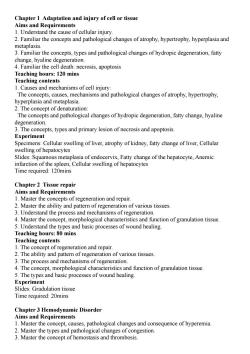
Chapter 1 Adaptation and injury of cell or tissue Aims and Requirements 1.Understand the cause of cellular injury. 2.Familiar the concepts and pathological changes of atrophy,hypertrophy,hyperplasia and metaplasia. 3.Familiar the concepts,types and pathological changes of hydropic degeneration,fatty change,hyaline degeneration. 4.Familiar the cell death:necrosis,apoptosis Teaching hours:120 mins Teaching contents 1.Causes and mechanisms of cell injury: The concepts,causes,mechanisms and pathological changes of atrophy,hypertrophy, hyperplasia and metaplasia. 2.The concept of denaturation: The concepts and pathological changes of hydropic degeneration,fatty change,hyaline degeneration. 3.The concepts,types and primary lesion of necrosis and apoptosis. Experiment Specimens:Cellular swelling of liver,atrophy of kidney,fatty change of liver,Cellular swelling of hepatocytes Slides:Squamous metaplasia of endocervix,Fatty change of the hepatocyte,Anemic infarction of the spleen,Cellular swelling of hepatocytes Time required:120mins Chapter 2 Tissue repair Aims and Requirements 1.Master the concepts of regeneration and repair. 2.Master the ability and pattern of regeneration of various tissues. 3.Understand the process and mechanisms of regeneration. 4.Master the concept,morphological characteristics and function of granulation tissue. 5.Understand the types and basic processes of wound healing Teaching hours:80 mins Teaching contents 1.The concept of regeneration and repair. 2.The ability and pattern of regeneration of various tissues. 3.The process and mechanisms of regeneration. 4.The concept,morphological characteristics and function of granulation tissue. 5.The types and basic processes of wound healing. Experiment Slides:Gradulation tissue Time required:20mins Chapter 3 Hemodynamic Disorder Aims and Requirements 1.Master the concept,causes,pathological changes and consequence of hyperemia 2.Master the types and pathological changes of congestion. 3.Master the concept of hemostasis and thrombosis
Chapter 1 Adaptation and injury of cell or tissue Aims and Requirements 1. Understand the cause of cellular injury. 2. Familiar the concepts and pathological changes of atrophy, hypertrophy, hyperplasia and metaplasia. 3. Familiar the concepts, types and pathological changes of hydropic degeneration, fatty change, hyaline degeneration. 4. Familiar the cell death: necrosis, apoptosis Teaching hours: 120 mins Teaching contents 1. Causes and mechanisms of cell injury: The concepts, causes, mechanisms and pathological changes of atrophy, hypertrophy, hyperplasia and metaplasia. 2. The concept of denaturation: The concepts and pathological changes of hydropic degeneration, fatty change, hyaline degeneration. 3. The concepts, types and primary lesion of necrosis and apoptosis. Experiment Specimens: Cellular swelling of liver, atrophy of kidney, fatty change of liver, Cellular swelling of hepatocytes Slides: Squamous metaplasia of endocervix, Fatty change of the hepatocyte, Anemic infarction of the spleen, Cellular swelling of hepatocytes Time required: 120mins Chapter 2 Tissue repair Aims and Requirements 1. Master the concepts of regeneration and repair. 2. Master the ability and pattern of regeneration of various tissues. 3. Understand the process and mechanisms of regeneration. 4. Master the concept, morphological characteristics and function of granulation tissue. 5. Understand the types and basic processes of wound healing. Teaching hours: 80 mins Teaching contents 1. The concept of regeneration and repair. 2. The ability and pattern of regeneration of various tissues. 3. The process and mechanisms of regeneration. 4. The concept, morphological characteristics and function of granulation tissue. 5. The types and basic processes of wound healing. Experiment Slides: Gradulation tissue Time required: 20mins Chapter 3 Hemodynamic Disorder Aims and Requirements 1. Master the concept, causes, pathological changes and consequence of hyperemia. 2. Master the types and pathological changes of congestion. 3. Master the concept of hemostasis and thrombosis
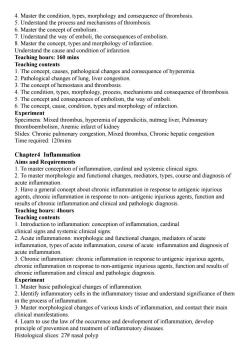
4.Master the condition,types,morphology and consequence of thrombosis 5.Understand the process and mechanisms of thrombosis. 6.Master the concept of embolism. 7.Understand the way of emboli,the consequences of embolism. 8.Master the concept,types and morphology of infarction. Understand the cause and condition of infarction. Teaching hours:160 mins Teaching contents 1.The concept,causes,pathological changes and consequence of hyperemia. 2.Pathological changes of lung,liver congestion. 3.The concept of hemostasis and thrombosis. 4.The condition,types,morphology,process,mechanisms and consequence of thrombosis. 5.The concept and consequences of embolism,the way of emboli. 6.The concept,cause,condition,types and morphology of infarction. Experiment Specimens:Mixed thrombus,hyperemia of appendicitis,nutmeg liver,Pulmonary thromboembolism,Anemic infarct of kidney Slides:Chronic pulmonary congestion,Mixed thrombus,Chronic hepatic congestion Time required:120mins Chapter4 Inflammation Aims and Requirements 1.To master conception of inflammation,cardinal and systemic clinical signs. 2.To master morphologic and functional changes,mediators,types,course and diagnosis of acute inflammation. 3.Have a general concept about chronic inflammation in response to antigenic injurious agents,chronic inflammation in response to non-antigenic injurious agents,function and results of chronic inflammation and clinical and pathologic diagnosis. Teaching hours:4hours Teaching contents 1.Introduction to inflammation:conception of inflammation,cardinal clinical signs and systemic clinical signs. 2.Acute inflammationn:morphologic and functional changes,mediators of acute inflammation,types of acute inflammation,course of acute inflammation and diagnosis of acute inflammation. 3.Chronic inflammation:chronic inflammation in response to antigenic injurious agents, chronic inflammation in response to non-antigenic injurious agents,function and results of chronic inflammation and clinical and pathologic diagnosis. Experiment 1.Master basic pathological changes of inflammation. 2.Identify inflammatory cells in the inflammatory tissue and understand significance of them in the process of inflammation. 3.Master morphological changes of various kinds of inflammation,and contact their main clinical manifestations. 4.Learn to use the law of the occurrence and development of inflammation,develop principle of prevention and treatment of inflammatory diseases. Histological slices:27#nasal polyp
4. Master the condition, types, morphology and consequence of thrombosis. 5. Understand the process and mechanisms of thrombosis. 6. Master the concept of embolism. 7. Understand the way of emboli, the consequences of embolism. 8. Master the concept, types and morphology of infarction. Understand the cause and condition of infarction. Teaching hours: 160 mins Teaching contents 1. The concept, causes, pathological changes and consequence of hyperemia. 2. Pathological changes of lung, liver congestion. 3. The concept of hemostasis and thrombosis. 4. The condition, types, morphology, process, mechanisms and consequence of thrombosis. 5. The concept and consequences of embolism, the way of emboli. 6. The concept, cause, condition, types and morphology of infarction. Experiment Specimens: Mixed thrombus, hyperemia of appendicitis, nutmeg liver, Pulmonary thromboembolism, Anemic infarct of kidney Slides: Chronic pulmonary congestion, Mixed thrombus, Chronic hepatic congestion Time required: 120mins Chapter4 Inflammation Aims and Requirements 1. To master conception of inflammation, cardinal and systemic clinical signs. 2. To master morphologic and functional changes, mediators, types, course and diagnosis of acute inflammation. 3. Have a general concept about chronic inflammation in response to antigenic injurious agents, chronic inflammation in response to non- antigenic injurious agents, function and results of chronic inflammation and clinical and pathologic diagnosis. Teaching hours: 4hours Teaching contents 1. Introduction to inflammation: conception of inflammation, cardinal clinical signs and systemic clinical signs. 2. Acute inflammationn: morphologic and functional changes, mediators of acute inflammation, types of acute inflammation, course of acute inflammation and diagnosis of acute inflammation. 3. Chronic inflammation: chronic inflammation in response to antigenic injurious agents, chronic inflammation in response to non-antigenic injurious agents, function and results of chronic inflammation and clinical and pathologic diagnosis. Experiment 1. Master basic pathological changes of inflammation. 2. Identify inflammatory cells in the inflammatory tissue and understand significance of them in the process of inflammation. 3. Master morphological changes of various kinds of inflammation, and contact their main clinical manifestations. 4. Learn to use the law of the occurrence and development of inflammation, develop principle of prevention and treatment of inflammatory diseases. Histological slices: 27# nasal polyp
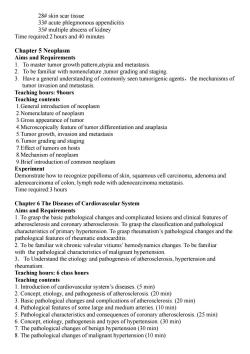
28#skin scar tissue 33#acute phlegmonous appendicitis 35#multiple abscess of kidney Time required:2 hours and 40 minutes Chapter 5 Neoplasm Aims and Requirements 1.To master tumor growth pattern,atypia and metastasis. 2.To be familiar with nomenclature,tumor grading and staging. 3.Have a general understanding of commonly seen tumorigenic agents,the mechanisms of tumor invasion and metastasis. Teaching hours:9hours Teaching contents 1.General introduction of neoplasm 2.Nomenclature of neoplasm 3.Gross appearance of tumor 4.Microscopically feature of tumor:differentiation and anaplasia 5.Tumor growth,invasion and metastasis 6.Tumor grading and staging 7.Effect of tumors on hosts 8.Mechanism of neoplasm 9.Brief introduction of common neoplasm Experiment Demonstrate how to recognize papilloma of skin,squamous cell carcinoma,adenoma and adenocarcinoma of colon,lymph node with adenocarcinoma metastasis. Time required:3 hours Chapter 6 The Diseases of Cardiovascular System Aims and Requirements 1.To grasp the basic pathological changes and complicated lesions and clinical features of atherosclerosis and coronary atherosclerosis.To grasp the classification and pathological characteristics of primary hypertension.To grasp rheumatism's pathological changes and the pathological features of rheumatic endocarditis. 2.To be familiar wit chronic valvular vitiums'hemodynamics changes.To be familiar with the pathological characteristics of malignant hypertension. 3.To Understand the etiology and pathogenesis of atherosclerosis,hypertension and rheumatism. Teaching hours:6 class hours Teaching contents 1.Introduction of cardiovascular system's diseases.(5 min) 2.Concept,etiology,and pathogenesis of atherosclerosis.(20 min) 3.Basic pathological changes and complications of atherosclerosis.(20 min) 4.Pathological features of some large and medium arteries.(10 min) 5.Pathological characteristics and consequences of coronary atherosclerosis.(25 min) 6.Concept,etiology,pathogenesis and types of hypertension.(30 min) 7.The pathological changes of benign hypertension(30 min) 8.The pathological changes of malignant hypertension(10 min)
28# skin scar tissue 33# acute phlegmonous appendicitis 35# multiple abscess of kidney Time required:2 hours and 40 minutes Chapter 5 Neoplasm Aims and Requirements 1. To master tumor growth pattern,atypia and metastasis. 2. To be familiar with nomenclature ,tumor grading and staging. 3. Have a general understanding of commonly seen tumorigenic agents,the mechanisms of tumor invasion and metastasis. Teaching hours: 9hours Teaching contents 1.General introduction of neoplasm 2.Nomenclature of neoplasm 3.Gross appearance of tumor 4.Microscopically feature of tumor:differentiation and anaplasia 5.Tumor growth, invasion and metastasis 6.Tumor grading and staging 7.Effect of tumors on hosts 8.Mechanism of neoplasm 9.Brief introduction of common neoplasm Experiment Demonstrate how to recognize papilloma of skin, squamous cell carcinoma, adenoma and adenocarcinoma of colon, lymph node with adenocarcinoma metastasis. Time required:3 hours Chapter 6 The Diseases of Cardiovascular System Aims and Requirements 1. To grasp the basic pathological changes and complicated lesions and clinical features of atherosclerosis and coronary atherosclerosis. To grasp the classification and pathological characteristics of primary hypertension. To grasp rheumatism’s pathological changes and the pathological features of rheumatic endocarditis. 2. To be familiar wit chronic valvular vitiums’ hemodynamics changes. To be familiar with the pathological characteristics of malignant hypertension. 3.To Understand the etiology and pathogenesis of atherosclerosis, hypertension and rheumatism. Teaching hours: 6 class hours Teaching contents 1. Introduction of cardiovascular system’s diseases. (5 min) 2. Concept, etiology, and pathogenesis of atherosclerosis. (20 min) 3. Basic pathological changes and complications of atherosclerosis. (20 min) 4. Pathological features of some large and medium arteries. (10 min) 5. Pathological characteristics and consequences of coronary atherosclerosis. (25 min) 6. Concept, etiology, pathogenesis and types of hypertension. (30 min) 7. The pathological changes of benign hypertension (30 min) 8. The pathological changes of malignant hypertension (10 min)
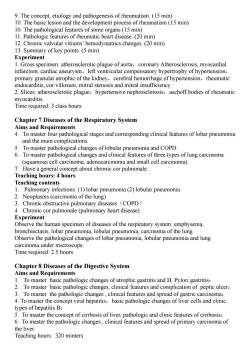
9.The concept,etiology and pathogenesis of rheumatism.(15 min) 10.The basic lesion and the development process of rheumatism(15 min) 10.The pathological features of some organs(15 min) 11.Pathologic features of rheumatic heart disease.(20 min) 12.Chronic valvular vitiums'hemodynamics changes.(20 min) 13.Summary of key points.(5 min) Experiment 1.Gross specimen:atherosclerotic plague of aorta,coronary Atherosclerosis,myocardial infarction,cardiac aneurysm,left ventricular compensatory hypertrophy of hypertension, primary granular atrophic of the kidney,cerebral hemorrhage of hypertension,rheumatic endocarditis,cor villosum,mitral stenosis and mitral insufficiency. 2.Slices:atherosclerotic plague,hypertensive nephrosclerosis,aschoff bodies of rheumatic myocarditis. Time required:3 class hours Chapter 7 Diseases of the Respiratory System Aims and Requirements 4.To master four pathological stages and corresponding clinical features of lobar pneumonia and the main complications. 5.To master pathological changes of lobular pneumonia and COPD. 6.To master pathological changes and clinical features of three types of lung carcinoma (squamous cell carcinoma,adenocarcinoma and small cell carcinoma). 7.Have a general concept about chronic cor pulmonale. Teaching hours:4 hours Teaching contents 1.Pulmonary infections:(1)lobar pneumonia(2)lobular pneumonia 2.Neoplasms(carcinoma of the lung) 3.Chronic obstructive pulmonary diseases (COPD) 4.Chronic cor pulmonale(pulmonary heart disease) Experiment Observe the human specimen of diseases of the respiratory system:emphysema, bronchiectasis,lobar pneumonia,lobular pneumonia,carcinoma of the lung Observe the pathological changes of lobar pneumonia,lobular pneumonia and lung carcinoma under microscope. Time required:2.5 hours Chapter 8 Diseases of the Digestive System Aims and Requirements 1.To master basic pathologic changes of atrophic gastritis and H.Pylori gastritis: 2.To master basic pathologic changes,clinical features and complication of peptic ulcer: 3.To master the pathologic changes,clinical features and spread of gastric carcinoma; 4.To master the concept viral hepatitis,basic pathologic changes of liver cells and clinic types of hepatitis B; 5.To master the concept of cirrhosis of liver,pathologic and clinic features of cirrhosis; 6.To master the pathologic changes,clinical features and spread of primary carcinoma of the liver. Teaching hours:320 minters
9. The concept, etiology and pathogenesis of rheumatism. (15 min) 10. The basic lesion and the development process of rheumatism (15 min) 10. The pathological features of some organs (15 min) 11. Pathologic features of rheumatic heart disease. (20 min) 12. Chronic valvular vitiums’ hemodynamics changes. (20 min) 13. Summary of key points. (5 min) Experiment 1. Gross specimen: atherosclerotic plague of aorta,coronary Atherosclerosis, myocardial infarction, cardiac aneurysm,left ventricular compensatory hypertrophy of hypertension, primary granular atrophic of the kidney,cerebral hemorrhage of hypertension,rheumatic endocarditis, cor villosum, mitral stenosis and mitral insufficiency. 2. Slices: atherosclerotic plague,hypertensive nephrosclerosis,aschoff bodies of rheumatic myocarditis. Time required: 3 class hours Chapter 7 Diseases of the Respiratory System Aims and Requirements 4. To master four pathological stages and corresponding clinical features of lobar pneumonia and the main complications. 5. To master pathological changes of lobular pneumonia and COPD. 6. To master pathological changes and clinical features of three types of lung carcinoma (squamous cell carcinoma, adenocarcinoma and small cell carcinoma). 7. Have a general concept about chronic cor pulmonale. Teaching hours: 4 hours Teaching contents 1. Pulmonary infections: (1) lobar pneumonia (2) lobular pneumonia 2. Neoplasms (carcinoma of the lung) 3. Chronic obstructive pulmonary diseases(COPD) 4. Chronic cor pulmonale (pulmonary heart disease) Experiment Observe the human specimen of diseases of the respiratory system: emphysema, bronchiectasis, lobar pneumonia, lobular pneumonia, carcinoma of the lung Observe the pathological changes of lobar pneumonia, lobular pneumonia and lung carcinoma under microscope. Time required: 2.5 hours Chapter 8 Diseases of the Digestive System Aims and Requirements 1. To master basic pathologic changes of atrophic gastritis and H. Pylori gastritis; 2. To master basic pathologic changes, clinical features and complication of peptic ulcer; 3. To master the pathologic changes , clinical features and spread of gastric carcinoma; 4. To master the concept viral hepatitis,basic pathologic changes of liver cells and clinic types of hepatitis B; 5. To master the concept of cirrhosis of liver, pathologic and clinic features of cirrhosis; 6. To master the pathologic changes , clinical features and spread of primary carcinoma of the liver. Teaching hours: 320 minters

Teaching contents 1.The concept of gastritis and classification of the gastritis;morphology and clinic feature of the gastritis 2.The concept of peptic ulcer;pathogenesis,morphology,clinical feature and complication of peptic ulcer 3.The concept of gastric carcinoma;etiology and pathogenesis;morphology,clinical feature and spread of the gastric carcinoma 4.The concept of viral hepatitis,basic pathologic changes of liver cells and clinic types of hepatitis B:morphology,clinical features 5.The concept of cirrhosis of liver,pathologic changers and clinic features of cirrhosis; 6.The concept of liver carcinoma;etiology and pathogenesis;morphology,clinical feature and spread of the liver carcinoma Experiment Specimens:peptic ulcer;bleeding of peptic ulcer;perforation;gastric carcinoma;viral hepatitis;cirrhosis;liver carcinoma Slides:peptic ulcer;gastric carcinoma;acute hepatitis;fulminant hepatitis;cirrhosis;liver carcinoma Time required:240 mins Chapter 9 Diseases of Urinary System Aims and Requirements 1.To master the etiology and pathogenesis of glomerulonephritis.. 2.To master the pathologic changes and clinical associations of acute diffuse proliferative glomerulonephritis,rapidly progressive glomerulonephritis,chronic sclerosing glomerulonephritis. 3.To be familiar with the etiology and pathogenesis of pyelonephritis,the pathologic changes and clinical associations of acute and chronic pyelonephritis. 4.To be familiar with the morphological characteristics of renal cell carcinoma,bladder urothelium carcinoma and Wilms tumour. Teaching hours:9hours Teaching contents 1.Introduction of renal structure 2.The etiology,pathogenesis and classification of glomerulonephritis 3.Acute diffuse proliferative glomerulonephritis 4.Rapidly progressive glomerulonephritis 5.Chronic sclerosing glomerulonephritis 6.Acute pyelonephritis 7.Chronic pyelonephritis 8.Renal cell carcinoma,bladder urothelium carcinoma and Wilms tumour 9.Summary of key points Experiment 1.Gross specimen:endocapillary proliferative glomerulonephritis,chronic glomerulonephritis,chronic pyelonephritis,carcinoma of kidney,carcinoma of the urinary bladder 2.Section:endocapillary proliferative glomerulonephritis,chronic glomerulonephritis, chronic pyelonephritis
Teaching contents 1. The concept of gastritis and classification of the gastritis ; morphology and clinic feature of the gastritis 2. The concept of peptic ulcer ; pathogenesis, morphology ,clinical feature and complication of peptic ulcer 3. The concept of gastric carcinoma; etiology and pathogenesis; morphology ,clinical feature and spread of the gastric carcinoma 4. The concept of viral hepatitis,basic pathologic changes of liver cells and clinic types of hepatitis B;morphology ,clinical features 5. The concept of cirrhosis of liver, pathologic changers and clinic features of cirrhosis; 6. The concept of liver carcinoma; etiology and pathogenesis; morphology ,clinical feature and spread of the liver carcinoma Experiment Specimens: peptic ulcer; bleeding of peptic ulcer ; perforation; gastric carcinoma; viral hepatitis; cirrhosis ; liver carcinoma Slides: peptic ulcer ; gastric carcinoma; acute hepatitis; fulminant hepatitis; cirrhosis; liver carcinoma Time required: 240 mins Chapter 9 Diseases of Urinary System Aims and Requirements 1. To master the etiology and pathogenesis of glomerulonephritis.. 2. To master the pathologic changes and clinical associations of acute diffuse proliferative glomerulonephritis, rapidly progressive glomerulonephritis, chronic sclerosing glomerulonephritis. 3. To be familiar with the etiology and pathogenesis of pyelonephritis, the pathologic changes and clinical associations of acute and chronic pyelonephritis. 4. To be familiar with the morphological characteristics of renal cell carcinoma, bladder urothelium carcinoma and Wilms tumour. Teaching hours: 9hours Teaching contents 1. Introduction of renal structure 2. The etiology, pathogenesis and classification of glomerulonephritis 3. Acute diffuse proliferative glomerulonephritis 4. Rapidly progressive glomerulonephritis 5. Chronic sclerosing glomerulonephritis 6. Acute pyelonephritis 7. Chronic pyelonephritis 8. Renal cell carcinoma, bladder urothelium carcinoma and Wilms tumour 9. Summary of key points Experiment 1. Gross specimen: endocapillary proliferative glomerulonephritis , chronic glomerulonephritis, chronic pyelonephritis, carcinoma of kidney, carcinoma of the urinary bladder 2. Section: endocapillary proliferative glomerulonephritis, chronic glomerulonephritis, chronic pyelonephritis
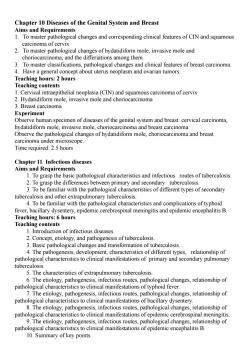
Chapter 10 Diseases of the Genital System and Breast Aims and Requirements 1.To master pathological changes and corresponding clinical features of CIN and squamous carcinoma of cervix 2.To master pathological changes of hydatidiform mole,invasive mole and choriocarcinoma,and the differiations among them. 3.To master classifications,pathological changes and clinical features of breast carcinoma. 4.Have a general concept about uterus neoplasm and ovarian tumors. Teaching hours:2 hours Teaching contents 1.Cervical intraepithelial neoplasia(CIN)and squamous carcinoma of cervix 2.Hydatidiform mole,invasive mole and choriocarcinoma 3.Breast carcinoma Experiment Observe human specimen of diseases of the genital system and breast:cervical carcinoma, hydatidiform mole,invasive mole,choriocarcinoma and breast carcinoma Observe the pathological changes of hydatidiform mole,choriocarcinoma and breast carcinoma under microscope. Time required:2.5 hours Chapter 11 Infectious diseases Aims and Requirements 1.To grasp the basic pathological characteristics and infectious routes of tuberculosis. 2.To grasp the differences between primary and secondary tuberculosis. 3.To be familiar with the pathological characteristics of different types of secondary tuberculosis and other extrapulmonary tuberculosis. 4.To be familiar with the pathological characteristics and complications of typhoid fever,bacillary dysentery,epidemic cerebrospinal meningitis and epidemic encephalitis B. Teaching hours:6 hours Teaching contents 1.Introduction of infectious diseases. 2.Concept,etiology,and pathogenesis of tuberculosis. 3.Basic pathological changes and transformation of tuberculosis. 4.The pathogenesis,development,characteristics of different types,relationship of pathological characteristics to clinical manifestations of primary and secondary pulmonary tuberculosis. 5.The characteristics of extrapulmonary tuberculosis. 6.The etiology,pathogenesis,infectious routes,pathological changes,relationship of pathological characteristics to clinical manifestations of typhoid fever. 7.The etiology,pathogenesis,infectious routes,pathological changes,relationship of pathological characteristics to clinical manifestations of bacillary dysentery. 8.The etiology,pathogenesis,infectious routes,pathological changes,relationship of pathological characteristics to clinical manifestations of epidemic cerebrospinal meningitis. 9.The etiology,pathogenesis,infectious routes,pathological changes,relationship of pathological characteristics to clinical manifestations of epidemic encephalitis B. 10.Summary of key points
Chapter 10 Diseases of the Genital System and Breast Aims and Requirements 1. To master pathological changes and corresponding clinical features of CIN and squamous carcinoma of cervix 2. To master pathological changes of hydatidiform mole, invasive mole and choriocarcinoma, and the differiations among them. 3. To master classifications, pathological changes and clinical features of breast carcinoma. 4. Have a general concept about uterus neoplasm and ovarian tumors. Teaching hours: 2 hours Teaching contents 1. Cervical intraepithelial neoplasia (CIN) and squamous carcinoma of cervix 2. Hydatidiform mole, invasive mole and choriocarcinoma 3. Breast carcinoma Experiment Observe human specimen of diseases of the genital system and breast: cervical carcinoma, hydatidiform mole, invasive mole, choriocarcinoma and breast carcinoma Observe the pathological changes of hydatidiform mole, choriocarcinoma and breast carcinoma under microscope. Time required: 2.5 hours Chapter 11 Infectious diseases Aims and Requirements 1. To grasp the basic pathological characteristics and infectious routes of tuberculosis. 2. To grasp the differences between primary and secondary tuberculosis. 3. To be familiar with the pathological characteristics of different types of secondary tuberculosis and other extrapulmonary tuberculosis. 4. To be familiar with the pathological characteristics and complications of typhoid fever, bacillary dysentery, epidemic cerebrospinal meningitis and epidemic encephalitis B. Teaching hours: 6 hours Teaching contents 1. Introduction of infectious diseases. 2. Concept, etiology, and pathogenesis of tuberculosis. 3. Basic pathological changes and transformation of tuberculosis. 4. The pathogenesis, development, characteristics of different types, relationship of pathological characteristics to clinical manifestations of primary and secondary pulmonary tuberculosis. 5. The characteristics of extrapulmonary tuberculosis. 6. The etiology, pathogenesis, infectious routes, pathological changes, relationship of pathological characteristics to clinical manifestations of typhoid fever. 7. The etiology, pathogenesis, infectious routes, pathological changes, relationship of pathological characteristics to clinical manifestations of bacillary dysentery. 8. The etiology, pathogenesis, infectious routes, pathological changes, relationship of pathological characteristics to clinical manifestations of epidemic cerebrospinal meningitis. 9. The etiology, pathogenesis, infectious routes, pathological changes, relationship of pathological characteristics to clinical manifestations of epidemic encephalitis B. 10. Summary of key points
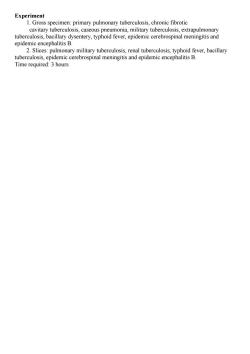
Experiment 1.Gross specimen:primary pulmonary tuberculosis,chronic fibrotic cavitary tuberculosis,caseous pneumonia,military tuberculosis,extrapulmonary tuberculosis,bacillary dysentery,typhoid fever,epidemic cerebrospinal meningitis and epidemic encephalitis B. 2.Slices:pulmonary military tuberculosis,renal tuberculosis,typhoid fever,bacillary tuberculosis,epidemic cerebrospinal meningitis and epidemic encephalitis B. Time required:3 hours
Experiment 1. Gross specimen: primary pulmonary tuberculosis, chronic fibrotic cavitary tuberculosis, caseous pneumonia, military tuberculosis, extrapulmonary tuberculosis, bacillary dysentery, typhoid fever, epidemic cerebrospinal meningitis and epidemic encephalitis B. 2. Slices: pulmonary military tuberculosis, renal tuberculosis, typhoid fever, bacillary tuberculosis, epidemic cerebrospinal meningitis and epidemic encephalitis B. Time required: 3 hours
按次数下载不扣除下载券;
注册用户24小时内重复下载只扣除一次;
顺序:VIP每日次数-->可用次数-->下载券;
- 安徽医科大学:《生殖医学基础与临床》课程教学资源(PPT课件讲稿)辅助生殖技术并发 The prevention and treatment of complications related to ART(主讲:许孝凤).ppt
- 安徽医科大学:《生殖医学基础与临床》课程教学资源(PPT课件讲稿)男性不育诊治方法与进展(主讲:贺小进).ppt
- 安徽医科大学:《生殖医学基础与临床》课程教学资源(PPT课件讲稿)圆头精子症受精失败机理、对策及其基因诊断平台的建立(主讲:朱复希).ppt
- 安徽医科大学:《生殖医学基础与临床》课程教学资源(PPT课件讲稿)多囊卵巢综合征(PCOS)Polycystic Ovarian Syndrome(主讲:徐玉萍).ppt
- 安徽医科大学:《生殖医学基础与临床》课程教学资源(PPT课件讲稿)5例无头精子症家系的临床分析和治疗对策(主讲:朱复希).ppt
- 安徽医科大学:《生殖医学基础与临床》课程教学资源(PPT课件讲稿)胚胎实验室的质量控制与管理(主讲:周平).ppt
- 安徽医科大学:《生殖医学基础与临床》课程教学资源(PPT课件讲稿)未成熟卵体外培养技术及其应用(主讲:邢琼).pptx
- 安徽医科大学:《生殖医学基础与临床》课程教学资源(PPT课件讲稿)人工授精 artificial insemination(主讲:邹薇薇).pptx
- 安徽医科大学:《生殖医学基础与临床》课程教学资源(PPT课件讲稿)辅助生殖伦理的基本常识与基本原则(主讲:周平).pptx
- 安徽医科大学:《生殖医学基础与临床》课程教学资源(电子教案)生殖医学相关的分子生物技术.doc
- 安徽医科大学:《生殖医学基础与临床》课程教学资源(PPT课件讲稿)人类配子、胚胎和性腺组织的冷冻(主讲:郝燕).pptx
- 安徽医科大学:《生殖医学基础与临床》课程教学资源(PPT课件讲稿)胚胎的培养(主讲:章志国).pptx
- 安徽医科大学:《生殖医学基础与临床》课程教学资源(PPT课件讲稿)精子发生的分子机制(主讲:朱复希).ppt
- 安徽医科大学:《生殖医学基础与临床》课程教学资源(PPT课件讲稿)转基因技术 Genetically modified animals(主讲:章志国).pptx
- 安徽医科大学:《毒理学基础》课程教学资源(试卷习题)复习题二.doc
- 安徽医科大学:《毒理学基础》课程教学资源(试卷习题)第十一章 管理毒理学(含答案).doc
- 安徽医科大学:《毒理学基础》课程教学资源(试卷习题)复习题一.doc
- 安徽医科大学:《毒理学基础》课程教学资源(试卷习题)第八章_外源化学物致癌作用(含答案).doc
- 安徽医科大学:《毒理学基础》课程教学资源(试卷习题)第九章 发育毒性与致畸作用(含答案).doc
- 安徽医科大学:《毒理学基础》课程教学资源(试卷习题)第七章 外源化学物致突变作用(含答案).doc
- 安徽医科大学:《病理学 Pathology(MBBS)》课程教学资源(授课教案).pdf
- 安徽医科大学:《医学微生物学》课程教学大纲 Medical microbiology(负责人:黄升海).pdf
- 安徽医科大学:《医学微生物学》课程教学授课教案 Medical microbiology.docx
- 安徽医科大学:《医学微生物学》课程PPT教学课件(理论课)01 绪论、细菌的形态结构(主讲:刘伯玉).ppt
- 安徽医科大学:《医学微生物学》课程PPT教学课件(理论课)02 细菌的生理、消毒灭菌与实验室安全、细菌的遗传和变异.ppt
- 安徽医科大学:《医学微生物学》课程PPT教学课件(理论课)03 细菌的感染与免疫、细菌感染的诊断与防治原则.ppt
- 安徽医科大学:《医学微生物学》课程PPT教学课件(理论课)04 球菌、肠道杆菌.ppt
- 安徽医科大学:《医学微生物学》课程PPT教学课件(理论课)10 螺旋体 Spirochete.ppt
- 安徽医科大学:《医学微生物学》课程PPT教学课件(理论课)05 弧菌属、空肠弯曲菌和幽门螺杆菌、厌氧性细菌、棒状杆菌属.ppt
- 安徽医科大学:《医学微生物学》课程PPT教学课件(理论课)06 分枝杆菌属、微小杆菌.ppt
- 安徽医科大学:《医学微生物学》课程PPT教学课件(理论课)07 支原体 Mycoplasma.ppt
- 安徽医科大学:《医学微生物学》课程PPT教学课件(理论课)08 立克次体 Rickettsiae.pptx
- 安徽医科大学:《医学微生物学》课程PPT教学课件(理论课)09 衣原体 Chlamydia.ppt
- 安徽医科大学:《医学微生物学》课程PPT教学课件(理论课)11 病毒的基本性状 General Properties of Viruses.ppt
- 安徽医科大学:《医学微生物学》课程PPT教学课件(理论课)12 病毒感染与免疫 Viral Infection and Immunity.ppt
- 安徽医科大学:《医学微生物学》课程PPT教学课件(理论课)13 病毒感染的检查方法及防治原则.ppt
- 安徽医科大学:《医学微生物学》课程PPT教学课件(理论课)14 呼吸道病毒 Respiratory Viruses.ppt
- 安徽医科大学:《医学微生物学》课程PPT教学课件(理论课)15 肠道病毒 Enteroviruses.ppt
- 安徽医科大学:《医学微生物学》课程PPT教学课件(理论课)16 急性胃肠炎病毒 Acute Gastroenteritis Viruses.ppt
- 安徽医科大学:《医学微生物学》课程PPT教学课件(理论课)17 肝炎病毒 Hepatitis viruses.ppt
